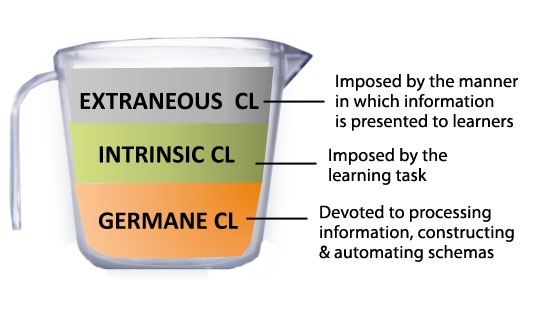Informational Processing Theory for the Classroom
Information Processing Theory
a study of cognitive development that says learners need to DO something with newly learned materials
(Above is a PDF file borrowed from Jonathan Lashley and Stephen Chou on Information Processing Theory. This is a phenomenal resource!)
Types of Memory
- Short Term Memory: passive, lasts 0.5 - 3 sec, affected by attention
- Working Memory: active, any disruption to rehearsal/coding creates decay (the deterioration of info), holds 5 - 9 items at a time. The practice of repeating the use of information over and over in this stage of memory is called rehearsal
- Long Term Memory: Activated, organized by schemes (previously established thoughts about a subject from past experiences), considered to have unlimited capacity and more-or-less permanent. The act of transferring information from working memory to long term memory is called encoding. This is where you are actively doing something with the new information given.
Key to Retaining Information:
Doing something with the new information (as previously mentioned) is called encoding. During encoding a learner may watch, listen, repeat, recall, etc. while trying to establish a good neurological pathway from the new information to "long term storage" in the brain.
Also, it is very important to Keep cognitive load in mind when trying to learn, recall, and remember new information.
Cognitive Load Theory

Basic definition
"Cognitive load theory (see Sweller, 1988, 1989) is concerned with the manner in which cognitive resources are focused and used during learning and problem solving.” (Chandler & Sweller, 1991, p. 294)
It is argued that cognitive load can be reduced for learners via instructional design
CLT is divided into three different types by Sweller; intrinsic, extraneous, and germane
Intrinsic: describes the mental effort a learner puts forth
Extraneous: is the methods in which information is presented to the learner
Germaine: refers to the mental effort required to store and create the new information into the learner’s knowledge bank, or schema
Leading Theorists?
CLT was developed by John Sweller in the 1980’s; however G.A. Miller was the first to suggest the our working memory has limits in the 1950’s
10 years after Sweller’s development of CLT; there were 5 learning effects produced from the results of his study: the completion-problem effect; modality effect; split-attention effect; worked-example effect; and expertise reversal effect
Since, researchers Paas and Van Merriënboer engineered a method to actually measure the mental effort a learner is using on a task
Task-invoked pupillary response is a reliable and sensitive measurement of cognitive load that is directly related to working memory
Recent theoretical advances include the incorporation of embodied cognition in order to predict the cognitive load resulting from embodied interactions
How does it apply to Education?
Overloading a learner with information and stimuli can have negative effects on task completion and comprehension
“Cognitive load theory has been designed to provide guidelines intended to assist in the presentation of information in a manner that encourages learner activities that optimize intellectual performance.”
Click here for an infographic about Cognitive Load Theory
More on Information Processing...Making Learning Multi-modal
The more modes you have working at one time, the more likely learners are going to remember (e.g. the more senses used, the better)
Click here for an infographic about how to incorporate the 5 senses into the classroom
We are Robots?
Not really, but sort of. This is a claim most cognitive psychologists make, that the human brain processes information much like a computer does. For example, if someone types a 45 page paper in Microsoft Word but the doesn't save it, would you expect him or her to be able to again open this document in a week? Most likely, no. Excluding the autosave feature etc., a computer has to be told to "remember this for later" and the user physically creates a pathway for the computer to use when the user desires to open (or recall) the document. Humans encode information in their brain much the same way! Humans, like computers, need to do something with new information so to store it in our brains so that we can recall it again later when needed. We need to create a similar pathway so we make sure our brain knows not to discard the newly learned information. This process is called encoding.
Click here for a diagram about how the human brain receives, stores, and recalls information
A good example of encoding we are all familiar with is ROY G BIV. This acronym was created as a way to remember the colors on the color spectrum: Red, Orange, Yellow, Green, Blue, Indigo, and Violet.
Additionally, the more times we practice pulling the information out, the easier and easier it becomes.
How Information Processing Theory Applies to the Classroom
For K-12 Classrooms
Most K-12 teachers (in my experience) hand out worksheets to help students practice (or rehearse) their new information. To improve students' encoding teachers should look for ways to incorporate more senses. For example, when learning new vocabulary (such as in a foreign language) teachers could have the students act out the words.
For Higher Education Classrooms
The more modes of information an instructor can provide to students the better. If the classroom or course doesn't condone itself to a lab-like lesson or environment to allow students to actually experience the concept on their own, instructors could point the students in the direction of a good video tutorial on that day's lesson. The instructor could even make their own video - a good use of graduate student's help!